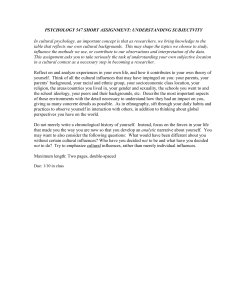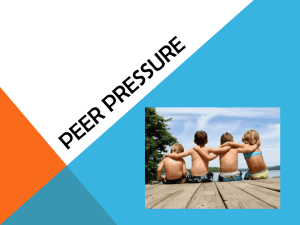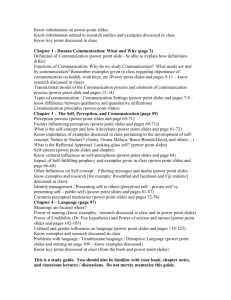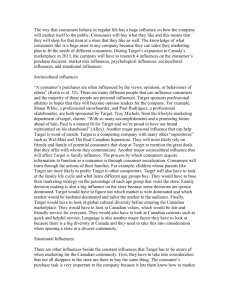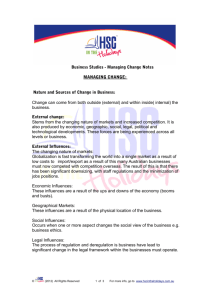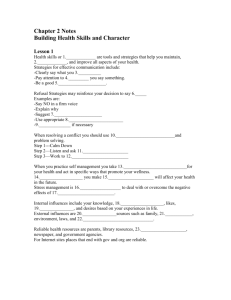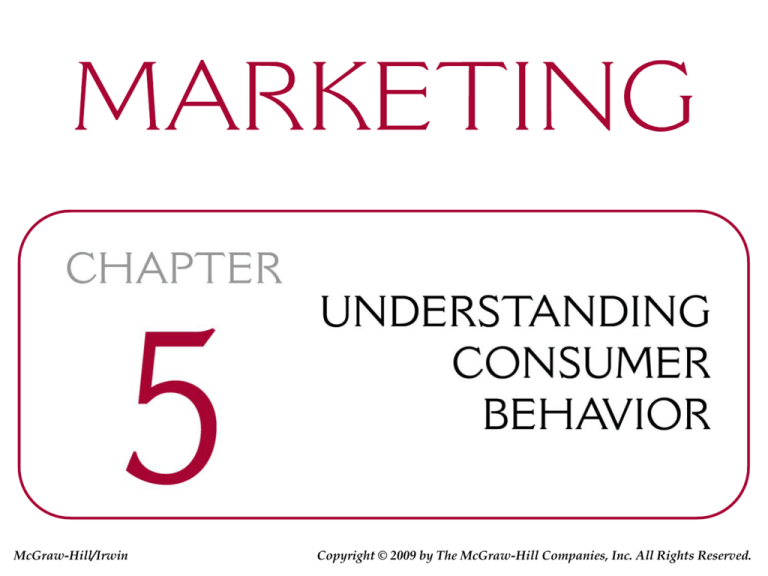
McGraw-Hill/Irwin
Copyright © 2009 by The McGraw-Hill Companies, Inc. All Rights Reserved.
LEARNING OBJECTIVES (LO)
AFTER READING CHAPTER 5, YOU SHOULD BE ABLE TO:
LO1
LO2
Describe the stages in the consumer
purchase decision process.
Distinguish among three variations of
the consumer purchase decision
process: routine, limited, and extended
problem solving.
5-2
LEARNING OBJECTIVES (LO)
AFTER READING CHAPTER 5, YOU SHOULD BE ABLE TO:
LO3
Identify major psychological influences
on consumer behavior.
LO4
Identify the major sociocultural
influences on consumer behavior.
5-3
LO1
PURCHASE DECISION PROCESS
PROBLEM RECOGNITION
Consumer Behavior
Purchase
Decision Process
5-4
CONSUMER PURCHASE
DECISION PROCESS
• Consumer Behavior
– Actions a person takes in purchasing
and using products and services –
including the mental and social
processes that come before and after
these actions
Slide 5-6
CONSUMER PURCHASE
DECISION PROCESS
• Purchase Decision Process
– Stages a buyer passes through in
making choices about which products
and services to buy
– The five stages are:
1) Problem recognition
2) Information search
3) Alternative evaluation
4) Purchase decision
5) Post-purchase behavior
Slide 5-6
FIGURE 5-1 The purchase decision process
consists of five stages
5-7
LO1
PURCHASE DECISION PROCESS
INFORMATION SEARCH
Internal Search
External Search
• Personal Sources
• Public Sources
• Market-Dominated Sources
5-8
CONSUMER PURCHASE
DECISION PROCESS
1. Problem Recognition: Perceiving a
Need
– Perceives a difference between a
person’s ideal and actual situations
big enough to trigger a decision
– Advertisements or salespeople can
activate a consumer’s decisionmaking process by showing the
shortcomings of competing or
currently owned products
Slide 5-6
CONSUMER PURCHASE
DECISION PROCESS
2. Information Search: Seeking Value
– Internal Search – scanning one’s
memory for previous experiences with
products or brands
– Often sufficient for frequently
purchased products
Slide 5-6
CONSUMER PURCHASE
DECISION PROCESS
2. Information Search: Seeking Value
– External Search – necessary when
past experience or knowledge is
insufficient, risk of making a bad
decision is high , and cost of
gathering information is low
Slide 5-6
CONSUMER PURCHASE
DECISION PROCESS
2. Information Search: Seeking Value
– External Search – primary sources
of external information:
a) Personal sources – friends and
relatives whom consumer trusts
b) Public sources – includes various
product-rating organizations like
Consumer Reports, government
agencies, or consumer-oriented TV
programs
Slide 5-6
CONSUMER PURCHASE
DECISION PROCESS
2. Information Search: Seeking Value,
cont.
– External Search – primary sources
of external information:
c) Marketer-dominated sources –
information from sellers that
include advertising, company
websites, salespeople and point-ofpurchase displays in stores
Slide 5-6
CONSUMER PURCHASE
DECISION PROCESS
3. Alternative Evaluation: Assessing
Value
– The information stage clarifies the
problem for consumers by:
– Suggesting criteria, or points to
consider, for the purchase
– Providing brand names that might
meet the criteria
– Developing consumer value
perceptions
Slide 5-6
LO1
PURCHASE DECISION PROCESS
ALTERNATIVE EVALUATION
Evaluative Criteria
Consideration Set
5-15
CONSUMER PURCHASE
DECISION PROCESS
3. Alternative Evaluation: Assessing
Value
– Consumer’s evaluative criteria
represent both the objective attributes
of a brand and the subjective ones
used to compare different products
and brands (often mentioned in
advertisements)
Slide 5-6
CONSUMER PURCHASE
DECISION PROCESS
3. Alternative Evaluation: Assessing
Value, cont.
– Consumers often have several criteria
for evaluating brands and these
criteria establish the consideration set
– the group of brands that a
consumer would consider acceptable
from among all brands in the product
class
Slide 5-6
FIGURE 5-2 Consumer Reports’ evaluation
of flash-memory MP3 players (abridged)
5-18
FIGURE 5-A What new car buyers consider
most important in deciding what new car to
buy
Slide 5-11
LO1
PURCHASE DECISION PROCESS
PURCHASE DECISION
Decide from Whom to Buy
Decide When to Buy
5-20
CONSUMER PURCHASE
DECISION PROCESS
4. Purchase Decision: Buying Value
– Having examined the alternatives, two
choices remain:
– From whom to buy, which is determined
by the seller’s terms of sales, past
purchase experience return policy, etc.
– When to buy, which is determined by
whether the product is on sale,
coupon/rebate, store’s atmosphere,
shopping experience, salesperson
persuasiveness, time pressure, financial
terms, etc.
Slide 5-6
CONSUMER PURCHASE
DECISION PROCESS
4. Purchase Decision: Buying Value
– The internet adds technological
dimension by allowing
consumers to:
• Gather information,
• Evaluate alternatives, and
• Make buying decisions
Slide 5-6
CONSUMER PURCHASE
DECISION PROCESS
5. Post Purchase Behavior: Value in
Consumption or Use
– After buying a product, the consumer
compares it expectations and is either
satisfied or dissatisfied.
Slide 5-6
Consumer Purchase Decision
Why is post purchase behavior important?
Slide 5-13
CONSUMER PURCHASE
DECISION PROCESS
5. Post Purchase Behavior, cont.
•
Customer’s satisfaction or dissatisfaction
with the consumption or use experience
affects their value perceptions and
repeated purchase behavior
– Satisfied buyers tell three other people
about their experience, while
dissatisfied buyers tell nine people
– Satisfied buyers tend to buy from the
same seller each time a purchase
decision arises, creating a huge
financial impact
Slide 5-6
CONSUMER PURCHASE
DECISION PROCESS
5. Post Purchase Behavior, cont.
– If dissatisfied, marketers must decide
whether:
• The product was deficient, leading
to a design change
• Consumer expectations were too
high if company’s advertising or
salesperson oversold product’s
features.
Slide 5-6
LO1
PURCHASE DECISION PROCESS
POSTPURCHASE BEHAVIOR
Cognitive Dissonance
5-28
CONSUMER PURCHASE
DECISION PROCESS
●
Cognitive Dissonance (Buyer’s Remorse)
● Situation
when a consumer experiences some
post purchase psychological tension or anxieties
● Results from an imbalance among purchaser’s
knowledge, beliefs, and attitudes
● “Should I have purchased this?”
●
Likely to increase in one of three cases:
● The
dollar vale of the purchase increases
● Rejected alternatives have desirable features that
chosen alternative does not
● When purchase decision has major effect on
buyer
CONSUMER PURCHASE
DECISION PROCESS
●
●
After a purchase, consumers seek to affirm
their choice – often seeking information or
approval from others or reading ads or
reviews about the brand chosen
Marketers can help buyers reduce cognitive
dissonance by providing information that
supports the chosen alternative, e.g., followup calls
CONSUMER PURCHASE
DECISION PROCESS
5. Post Purchase Behavior: Value in
Consumption or Use
– Many firms focus attention on post
purchase behavior to maximize
customer satisfaction and retention by
offering toll-free numbers, liberalized
return policies, and providing staff
training in handling customer
complaints
Slide 5-6
PURCHASE DECISION PROCESS
CONSUMER INVOLVEMENT & PROBLEM SOLVING
Involvement and Problem-Solving
Slide 5-15
CONSUMER PURCHASE
DECISION PROCESS
• Involvement and Problem-Solving
Variations
• Consumers may skip or minimize one or
more steps in the decision process
depending on the level of involvement – the
personal, social, and economic significance
of the purchase to the consumer
Slide 5-15
CONSUMER PURCHASE
DECISION PROCESS
• Involvement and Problem-Solving
Variations
• For High-Involvement Purchases:
– Item typically has at least one of three
characteristics: 1) is expensive; 2) can
have serious personal consequences;
or, 3) could reflect on one’s image
– Consumers engage in extensive
information search, consider many
product attributes and brands, and use
word of mouth
Slide 5-15
CONSUMER PURCHASE
DECISION PROCESS
• Involvement and Problem-Solving
Variations
• For Low-Involvement Purchases:
– The product has little impact
Slide 5-15
PURCHASE DECISION PROCESS
CONSUMER INVOLVEMENT & PROBLEM SOLVING
• Involvement and Problem-Solving
Variations
– Three general problem-solving
variations in the consumer purchase
decision process:
1. Routine Problem Solving
2.
Limited Problem Solving
3.
Extended Problem Solving
Slide 5-15
CONSUMER PURCHASE
DECISION PROCESS
• Involvement and Problem-Solving
Variations
1. Routine Problem Solving
– The purchase process is habitual and
involves little effort seeking external
information and evaluating alternatives
– Typically used for low-priced, frequently
purchased products
Slide 5-15
CONSUMER PURCHASE
DECISION PROCESS
• Involvement and Problem-Solving
Variations
• Limited Problem Solving
– Consumers seek some information to
evaluate alternative brands and attributes
– Used when buyer has little time or effort
to spend
Slide 5-15
CONSUMER PURCHASE
DECISION PROCESS
• Involvement and Problem-Solving
Variations
• Extended Problem Solving
– Each stage of the consumer buying
process is used, including considerable
time and effort on external information
search to identify and evaluate the
attributes of several brands in the
consideration set
– High-involvement purchases
Slide 5-15
FIGURE 5-3 Comparison of problem-solving
variations: extended, limited, and routine
5-40
CONSUMER PURCHASE
DECISION PROCESS
• Involvement and Marketing Strategy
• For low-involvement products whose brands
are market-share leaders, marketers should
– Maintain product quality
– Avoid stockouts so buyers would not
substitute a competing brand
– Develop ads that reinforce consumers’
knowledge or assure buyers that they made
the right choice
Slide 5-15
CONSUMER PURCHASE
DECISION PROCESS
• Involvement and Marketing Strategy
• For low-involvement products whose brands
are market challengers, marketers should:
– Use free samples, coupons, and rebates to
encourage trial of their product to break a
buying habit
– Develop ads that get their brand into a
consumer’s consideration set
– Link brand attributes with high involvement
issues
Slide 5-15
CONSUMER PURCHASE
DECISION PROCESS
• Involvement and Marketing Strategy
• For high-involvement products whose brands
are market-share leaders, marketers should:
– Use advertising
– Use personal selling
Slide 5-15
CONSUMER PURCHASE
DECISION PROCESS
• Involvement and Marketing Strategy
• For high-involvement products whose brands
are market challengers, marketers should:
– Use comparative ads and novel evaluative
criteria for judging competing brands
Slide 5-15
FIGURE 5-4 Influences on the consumer
purchase decision process from both
internal and external sources
5-45
PSYCHOLOGICAL INFLUENCES
ON CONSUMER BEHAVIOR
• Motivation
– Energizing force that stimulates
behavior to satisfy a need
– Marketers try to arouse these needs
which are hierarchical
– Range from basic to learned needs
Slide 5-22
LO3
PSYCHOLOGICAL INFLUENCES
ON CONSUMER BEHAVIOR
MOTIVATION AND PERSONALITY
Hierarchy of Needs
• Psychological Needs
• Safety Needs
• Social Needs
• Personal Needs
• Self-Actualization Needs
5-47
FIGURE 5-5 Hierarchy of needs
5-48
PSYCHOLOGICAL INFLUENCES
ON CONSUMER BEHAVIOR
• Perception – process by which
individuals select, organize, and
interpret information to create a
meaningful picture of the world
Slide 5-24
PSYCHOLOGICAL INFLUENCES
ON CONSUMER BEHAVIOR
• Selective Perception – process of
filtering of exposure,
comprehension, and retention by the
human brain to organize and
interpret information
Slide 5-24
PSYCHOLOGICAL INFLUENCES
ON CONSUMER BEHAVIOR
• Selective Exposure occurs
– When people pay attention to messages
that are consistent with their own
attitudes and beliefs and ignore
messages that are inconsistent
– At the post purchase stage when
consumers read ads for the brand they
just bought
– When a need exists, such as being
hungry
Slide 5-24
PSYCHOLOGICAL INFLUENCES
ON CONSUMER BEHAVIOR
• Selective Comprehension –
involves interpreting information so
that it is consistent with a person’s
attitudes and beliefs
Slide 5-24
PSYCHOLOGICAL INFLUENCES
ON CONSUMER BEHAVIOR
• Selective Retention – means that
consumers do not remember all the
information they see, read, or hear,
even minutes after exposure to it
– This affects the internal and external
information search stages of the
consumer decision process
Slide 5-24
PSYCHOLOGICAL INFLUENCES
ON CONSUMER BEHAVIOR
• Subliminal Perception – means
that people see or hear messages
without being aware of them
– Hotly debated issue with more popular
appeal than scientific support
– Research suggests that such messages
have limited effects on behavior
Slide 5-24
PSYCHOLOGICAL INFLUENCES
ON CONSUMER BEHAVIOR
• Subliminal advertising is aimed at the subconscious
level of awareness.
• Almost 50 years ago, a New Jersey movie theater tried
to boost concession sales by flashing the words Eat
Popcorn and Drink Coca-Cola.
• Research has shown that subliminal messages cannot
force receivers to purchase goods that they would not
consciously want.
• Subliminal advertising has been universally condemned
as manipulative, most experts believe that it is
exceedingly unlikely to induce purchasing except by
people already inclined to buy
Slide 5-24
ETHICS AND SOCIAL
RESPONSIBILITY ALERT
The Ethics of Subliminal Messages
Slide 5-25
PSYCHOLOGICAL INFLUENCES
ON CONSUMER BEHAVIOR
• Perceived Risk – represents the
anxieties felt because the consumer
cannot anticipate the outcomes of a
purchase but believes that their may
be a negative consequence
Slide 5-24
PSYCHOLOGICAL INFLUENCES
ON CONSUMER BEHAVIOR
• Negative consequences of
Perceived Risk include:
– Size of financial outlay for product
– Risk of physical harm
– Performance of the product
– Psychosocial – what will other people
think or say
Slide 5-24
PSYCHOLOGICAL INFLUENCES
ON CONSUMER BEHAVIOR
• Perceived Risk affects the
information stage of the consumer
purchase decision process
– The greater the perceived risk, the more
extensive the external search is likely to
be
Slide 5-24
PSYCHOLOGICAL INFLUENCES
ON CONSUMER BEHAVIOR
• Marketers try to reduce consumer’s
perceived risk and encourage
purchases by using one or more
strategies:
• Obtain Seals of Approval
• Secure Endorsements from Influential People
• Provide Free Trials
• Give Extensive Usage Instructions
• Provide Warranties and Guarantees
Slide 5-26
PSYCHOLOGICAL INFLUENCES
ON CONSUMER BEHAVIOR
Learning
Slide 5-24
PSYCHOLOGICAL INFLUENCES
ON CONSUMER BEHAVIOR
• Learning – refers to those
behaviors that result from
1) Repeated experience
2) Reasoning
Slide 5-24
PSYCHOLOGICAL INFLUENCES
ON CONSUMER BEHAVIOR
• Learning – refers to those
behaviors that result from
•
•
•
Behavioral
Cognitive
Brand Loyalty
Slide 5-24
PSYCHOLOGICAL INFLUENCES
ON CONSUMER BEHAVIOR
• Behavioral Learning – process of
developing automatic responses to a
type of situation built up through
repeated exposure to it
Slide 5-24
PSYCHOLOGICAL INFLUENCES
ON CONSUMER BEHAVIOR
• Four variables are key to how to
how consumers learn from repeated
experience:
1. Drive: need that moves an individual to action
2. Cue: stimulus or symbol that one perceives
3. Response: action taken to satisfy a drive
4. Reinforcement: the reward
Slide 5-26
PSYCHOLOGICAL INFLUENCES
ON CONSUMER BEHAVIOR
• Marketers use two concepts from
behavioral learning theory:
1) Stimulus generalization – when a response
elicited by one stimulus (cue) is
generalized to another
– e.g., using the same brand name for
different products
2) Stimulus discrimination – refers to one’s
ability to perceive differences among
similar products
Slide 5-24
PSYCHOLOGICAL INFLUENCES
ON CONSUMER BEHAVIOR
• Cognitive Learning – involves
making connections between two or
more ideas or simply observing the
outcomes of others’ behaviors and
adjusting one’s own behavior
accordingly through thinking,
reasoning, and problem solving
Slide 5-24
PSYCHOLOGICAL INFLUENCES
ON CONSUMER BEHAVIOR
• Brand Loyalty – a favorable attitude
toward, and a consistent purchase of a
single brand over time
•
•
Results from positive reinforcement of
previous actions
Reduces risk and saves time due to
favorable results
Slide 5-24
FIGURE 5-B Brand loyalty tendency by
product category
Slide 5-30
PSYCHOLOGICAL INFLUENCES
ON CONSUMER BEHAVIOR
Values, Beliefs, and Attitudes
Slide 5-24
PSYCHOLOGICAL INFLUENCES
ON CONSUMER BEHAVIOR
• Values, Beliefs, and Attitudes –
play a central role in
– Consumer decision making, and
– Related marketing actions
Slide 5-24
PSYCHOLOGICAL INFLUENCES
ON CONSUMER BEHAVIOR
• Values, Beliefs, and Attitudes
– Attitude Formation
• Attitudes – learned predisposition to
respond to an object or class of
objects in a consistently favorable or
unfavorable way
• Shaped by values and beliefs
• Marketers are concerned with
personal values, which affect
attitudes by influencing the
importance assigned to specific
product attributes
Slide 5-31
PSYCHOLOGICAL INFLUENCES
ON CONSUMER BEHAVIOR
• Values, Beliefs, and Attitudes
– Attitude Formation, cont.
• Beliefs – consumer's subjective
perception of how a product or brand
performs on different attributes
• Based on personal experience,
advertising, and discussions with
other people
• Beliefs about product attributes
create favorable or unfavorable
attitudes the consumer has toward
certain products, services, and
brands
Slide 5-31
PSYCHOLOGICAL INFLUENCES
ON CONSUMER BEHAVIOR
• Values, Beliefs, and Attitudes
– Attitude Change
• Changing beliefs about the extent
to which a brand has certain
attributes
• Changing the perceived
importance of attributes
• Adding new attributes to the
product
Slide 5-31
PSYCHOLOGICAL INFLUENCES
ON CONSUMER BEHAVIOR
• Lifestyle – mode of living that is
identified by how people spend their time
and resources, what they consider
important in their environment, and what
they think of themselves and the world
around them
Slide 5-24
PSYCHOLOGICAL INFLUENCES
ON CONSUMER BEHAVIOR
• Psychographics – analysis of consumer
lifestyles
a. Combines consumer psychology, lifestyle,
and demographics to uncover motivations
for buying and using products
b. Provides insights into customer needs and
wants and is useful in segmenting and
targeting consumers for new and existing
products and services
Slide 5-24
PSYCHOLOGICAL INFLUENCES
ON CONSUMER BEHAVIOR
• VALS – psychographic system
developed by SRIC-BI that identifies
eight consumer segments based on;
1) The consumer’s primary motivation for
buying and having certain products and
services, and
2) The consumer’s resources
Slide 5-24
PSYCHOLOGICAL INFLUENCES
ON CONSUMER BEHAVIOR
• VALS
1) Consumers are inspired by one of three
primary motivations – ideals,
achievements, and self expression – that
give meaning to their self and govern
their activities
2) Consumers’ resources include
psychological, physical, demographic,
and material capacities; such as income,
self-confidence, and risk-taking
Slide 5-24
PSYCHOLOGICAL INFLUENCES
ON CONSUMER BEHAVIOR
VALS™
• Thinkers
• Experiencers
• Believers
• Makers
• Achievers
• Innovators
• Strivers
• Survivors
Slide 5-33
WEB LINK
Identify Your VALS Profile
Slide 5-34
VALS™ Consumer Segments
How do consumers make purchase
decisions?
Slide 5-35
Concept Check
1. What three attitude-change
approaches are most common?
A: (1) Change beliefs about the extent
to which a brand has certain
attributes. (2) Change the
perceived importance of attributes.
(3) Add new attributes.
Slide 5-37
Concept Check
2. What does lifestyle mean?
A: Lifestyle is a mode of living that
is identified by how people spend
their time and resources, what they
consider important in their
environment, and what they think
of themselves and the world
around them .
Slide 5-38
SOCIOCULTURAL INFLUENCES
ON CONSUMER BEHAVIOR
Slide 5-39
SOCIOCULTURAL INFLUENCES
ON CONSUMER BEHAVIOR
• Personal Influence
– Opinion Leaders – are individuals who
exert direct or indirect social influence
over others
• Thought to be knowledgeable
• their opinions influence other’s
choices
• Only about 10 percent of U.S. adults
• reaching them is a challenge
• Celebrities as spokespersons to
represent products
Slide 5-39
SOCIOCULTURAL INFLUENCES
ON CONSUMER BEHAVIOR
• Word of Mouth
– People influencing each other during
conversations and is powerful information
source as it involves friends viewed as
trustworthy
• 67 percent of U.S. product sales are
directly based on word-of-mouth activity
among friends, family, etc.
• Companies recruit and deploy people to
produce buzz – popularity created by
consumer word-of-mouth
Slide 5-39
FIGURE 5-C Word of mouth influence
Slide 5-41
SOCIOCULTURAL INFLUENCES
ON CONSUMER BEHAVIOR
• Reference Groups
– People to whom an individual looks as a
basis for self-appraisal or as a source of
personal standards
• Have important influence on the
purchase of luxury products, but not of
necessities
Slide 5-39
SOCIOCULTURAL INFLUENCES
ON CONSUMER BEHAVIOR
Reference Groups
•
•
•
•
•
Groups whose value structures and standards
influence a person’s behavior
Need not be a member to be influenced by it
Consumers often try to coordinate their
purchase behavior with their perception of the
values of their reference groups
Children are especially vulnerable
Appear in other countries
Slide 5-39
SOCIOCULTURAL INFLUENCES
ON CONSUMER BEHAVIOR
Reference Groups—Member’s Purchases
Requires two conditions:
1. The purchased product must be one that
others can see and identify.
2. The purchased item must be conspicuous; it
must stand out as something unusual, a
brand or product that not everyone owns.
Slide 5-39
LO4
SOCIOCULTURAL INFLUENCES
ON CONSUMER BEHAVIOR
REFERENCE GROUPS
Reference Groups
• Membership Group
• Aspiration Group
• Dissociative Group
5-92
SOCIOCULTURAL INFLUENCES
ON CONSUMER BEHAVIOR
• Reference Groups
– Three groups have marketing
implications:
1. Membership Group – one that a person
actually belongs, such as fraternities
and sororities, social clubs, etc.
2. Aspiration group – one that a person
wishes to be a member of or identified
with, such as a professional society
Slide 5-39
SOCIOCULTURAL INFLUENCES
ON CONSUMER BEHAVIOR
• Reference Groups
– Three groups have marketing
implications:
3. Dissociative Group – one that a
person wishes to maintain a
distance from due to differences in
values or behaviors
Slide 5-39
SOCIOCULTURAL INFLUENCES
ON CONSUMER BEHAVIOR
•
Family Influence – family influence on
consumer behavior results from three
sources:
1. Consumer Socialization
2. Family Life Cycle
3. Family Decision Making
Slide 5-43
SOCIOCULTURAL INFLUENCES
ON CONSUMER BEHAVIOR
Family Influences
Most people are members of two families
during their lifetimes:
1. the one they are born into, and
2. the one they form later in life
Slide 5-43
SOCIOCULTURAL INFLUENCES
ON CONSUMER BEHAVIOR
Family Influences
•
•
The family group is perhaps the most
important determinant of consumer
behavior
Each family has norms of expected
behavior and different roles and status
relationships for its members
Slide 5-43
SOCIOCULTURAL INFLUENCES
ON CONSUMER BEHAVIOR
Family Influences
•
Consumer Socialization
Process by which people acquire the
skills, knowledge, and attitudes
necessary to function as consumers
Slide 5-43
SOCIOCULTURAL INFLUENCES
ON CONSUMER BEHAVIOR
Family Influences
•
Consumer Socialization
Children learn to purchase by:
a. Interacting with adults in purchasing
situations
b. Engaging in their own purchasing and
usage experiences
Slide 5-43
SOCIOCULTURAL INFLUENCES
ON CONSUMER BEHAVIOR
Family Influences
•
– Family Life Cycle
Describes the distinct phases that a
family progresses through from
formation to retirement – each phase
bringing identifiable purchasing
behaviors
Slide 5-43
FIGURE 5-6 Modern family life cycle
Slide 5-45
SOCIOCULTURAL INFLUENCES
ON CONSUMER BEHAVIOR
Family Influences
•
Family Decision Making
Three decision styles exist:
1. Partner-dominant decisions – either
partner is individually responsible
2. Joint decision-making style – both
partners jointly make decisions
3. Partners independently make equal
numbers of decisions
Slide 5-43
SOCIOCULTURAL INFLUENCES
ON CONSUMER BEHAVIOR
Family Influences
•
Family Decision Making
•
Five roles of individual family members
exist in the purchase process:
1.
2.
3.
4.
5.
Information gatherer
Influencer
Decision maker
Purchaser
User
Slide 5-43
SOCIOCULTURAL INFLUENCES
ON CONSUMER BEHAVIOR
Family Influences
•
Family Decision Making
•
Family members assume different roles for
different products and services
1. 89 percent of wives either influence or make outright
purchase of men’s clothing
2. Men spend 40 percent of all food shopping dollars
3. Children under 12 directly influence more than $300B
in annual family purchases
4. Teenagers influence another $500B and spend
another $175M of their own money annually
Slide 5-43
Haggar Clothing
What role do women play in this purchase?
Slide 5-46
SOCIOCULTURAL INFLUENCES
ON CONSUMER BEHAVIOR
Social Class
The relatively permanent, homogeneous
divisions in a society into which people
sharing similar values, interests, and
behavior can be grouped
Slide 5-47
SOCIOCULTURAL INFLUENCES
ON CONSUMER BEHAVIOR
Social Class
a. A person’s occupation, source of
income (not level of income)
determine his or her social class
b. Three major social class categories
exist –upper, middle, and lower – with
subcategories within each
c. Persons within social classes exhibit
common values, attitudes, and buying
behaviors
Slide 5-47
SOCIOCULTURAL INFLUENCES
ON CONSUMER BEHAVIOR
Social Class
d. Lower class people are more emotional
than rational, think in concrete, not
abstract terms, and see fewer opportunities
e. Members of the upper class focus on
achievements and the future and think in
abstract terms
f. Companies use social class to identify and
reach prospects for their products and
services and also recognize differences in
media preferences among the classes
Slide 5-47
SOCIOCULTURAL INFLUENCES
ON CONSUMER BEHAVIOR
Culture and Subculture
– Culture refers to the set of ideas, and
attitudes that are learned and shared
among members of a group
– Subculture are groups within the
larger, or national, culture with unique
values, ideas, and attitudes
– The three largest racial/ethnic
subcultures in the U.S. are African
Americans, Hispanics, and Asian
Americans
Slide 5-47
SOCIOCULTURAL INFLUENCES
ON CONSUMER BEHAVIOR
• Culture and Subculture
African American Buying Patterns
Hispanic Buying Patterns
Asian American Buying Patterns
Assimulated
Nonassimulated
Slide 5-47
SOCIOCULTURAL INFLUENCES
ON CONSUMER BEHAVIOR
Subcultures
• Although not homogeneous, each has
identifiable consumer behavior profiles
• More important than national origin are
differences in acculturation
– degree in which newcomers have
adapted to U.S. culture
Slide 5-47
SOCIOCULTURAL INFLUENCES
ON CONSUMER BEHAVIOR
African-American Consumers
•
Buying power rose faster over last decade than
average consumer
•
Family structure may differ – median age
younger; greater percentage headed by women
•
As with all subcultures, avoid approaching all
African-American consumers same way
Slide 5-47
SOCIOCULTURAL INFLUENCES
ON CONSUMER BEHAVIOR
Hispanic Consumers
•
Not homogeneous group – cultural differences
among segments affect consumer preferences
•
Marketing research reveals some
homogeneous tendencies: conservative
buyers, brand loyal, family oriented
•
Largely unacculturated, partially
unacculturated, and highly acculturated
Slide 5-47
SOCIOCULTURAL INFLUENCES
ON CONSUMER BEHAVIOR
Asian-American Consumers
•
•
•
Very diverse group – more than two dozen
language groups and often several dialects of
each language
Each also has its own religion and value
system
Like Hispanic consumers, Asian-American
subgroups differ depending on their level of
acculturation
Slide 5-47
LO3
PSYCHOLOGICAL INFLUENCES
ON CONSUMER BEHAVIOR
LEARNING
Learning
Behavioral Learning
• Drive (Hunger)
• Response
• Cue
• Reinforcement
5-117
LO4
SOCIOCULTURAL INFLUENCES
ON CONSUMER BEHAVIOR
SOCIAL CLASS
Social Class
• Upper Class
• Middle Class
• Working/Lower Class
5-118
Consumer Behavior
Consumer behavior consists of
the actions a person takes in
purchasing and using products
and services, including the mental
and social processes that come
before and after these actions.
5-119
Purchase Decision Process
The purchase decision process
consists of the five stages a buyer
passes through in making choices
about which products and services
to buy: (1) problem recognition,
(2) information search, (3) alternative
evaluation, (4) purchase decision,
and (5) postpurchase behavior.
5-120
Evaluative Criteria
Evaluative criteria consist of
Factors that represent both the
objective attributes of a brand
and the subjective ones a
consumer uses to compare
different products and brands.
5-121
Consideration Set
A consideration set is the group
of brands that a consumer would
consider acceptable from among
all the brands in the product class
of which he or she is aware.
5-122
Cognitive Dissonance
Cognitive dissonance is the
feeling of postpurchase
psychological tension or anxiety
consumers may experience when
faced with two or more highly
attractive alternatives.
5-123
Involvement
Involvement is the personal,
social, and economic significance
of the purchase to the consumer.
5-124
Situational Influences
Situational influences consist of the five
aspects of the purchase situation that
impacts the consumer’s purchase decision
process:
(1) the purchase task,
(2) social surroundings,
(3) physical surroundings,
(4) temporal effects, and
(5) antecedent states.
5-125
Motivation
Motivation is the energizing force
that stimulates behavior to satisfy
a need.
5-126
Personality
Personality is a person’s
consistent behaviors or responses
to recurring situations.
5-127
Self-Concept
Self-concept is the way people
see themselves and the way they
believe others see them.
5-128
Perception
Perception is the process by
which an individual selects,
organizes, and interprets
information to create a
meaningful picture of the world.
5-129
Subliminal Perception
Subliminal perception involves
seeing or hearing messages
without being aware of them.
5-130
Perceived Risk
Perceived risk is the anxieties
felt because the consumer cannot
anticipate the outcomes of a
purchase but believes that there
may be negative consequences.
5-131
Learning
Learning consists of those
behaviors that result from
(1) repeated experience and
(2) reasoning.
5-132
Brand Loyalty
Brand loyalty is a favorable
attitude toward and consistent
purchase of a single brand over
time.
5-133
Attitude
An attitude is a learned
predisposition to respond to an
object or class of objects in a
consistently favorable or
unfavorable way.
5-134
Beliefs
Beliefs are a consumer’s
subjective perception of how a
product or brand performs on
different attributes based on
personal experience, advertising,
and discussions with other people.
5-135
Lifestyle
Lifestyle is a mode of living that
is identified by how people spend
their time and resources, what
they consider important in their
environment, and what they think
of themselves and the world
around them.
5-136
Opinion Leaders
Opinion leaders are individuals
who exert direct or indirect social
influence over others.
5-137
Word of Mouth
Word of mouth involves the
influencing of people during
conversations.
5-138
Reference Groups
Reference groups consists of
people to whom an individual
looks as a basis for self-appraisal
or as a source of personal
standards.
5-139
Consumer Socialization
Consumer socialization is the
process by which people acquire
the skills, knowledge, and
attitudes necessary to function as
consumers.
5-140
Family Life Cycle
A family life cycle consists of
the distinct phases that a family
progresses through from
formation to retirement, each
phase bringing with it identifiable
purchasing behaviors.
5-141
Social Class
Social class consists of the
relatively permanent,
homogeneous divisions in a
society into which people sharing
similar values, interests, and
behavior can be grouped.
5-142
Subcultures
Subcultures are the subgroups
within the larger, or national,
culture with unique values, ideas,
and attitudes.
5-143

